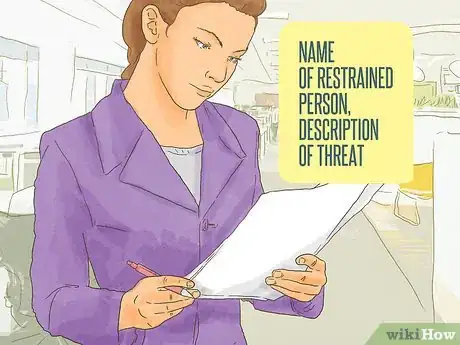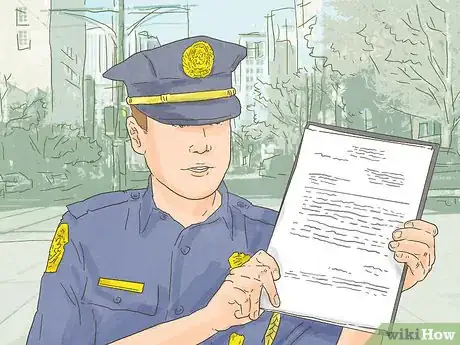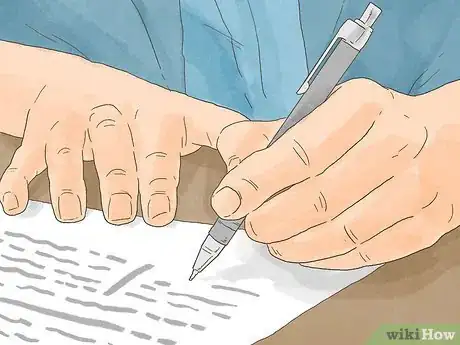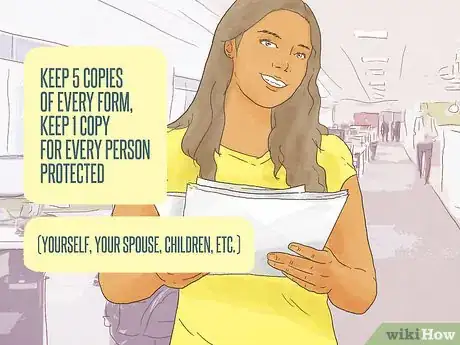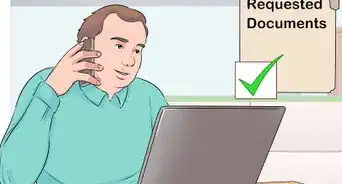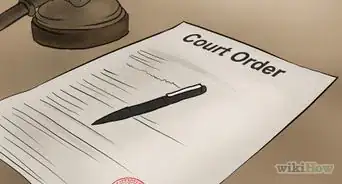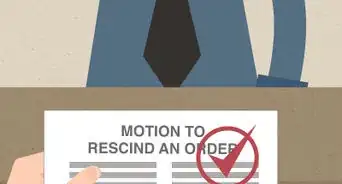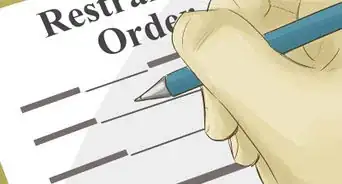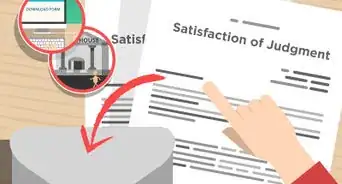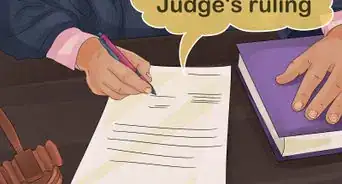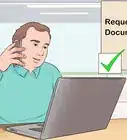This article was written by Jennifer Mueller, JD. Jennifer Mueller is an in-house legal expert at wikiHow. Jennifer reviews, fact-checks, and evaluates wikiHow's legal content to ensure thoroughness and accuracy. She received her JD from Indiana University Maurer School of Law in 2006.
This article has been viewed 57,149 times.
Whether they are a spurned lover, a nasty neighbor, or a creepy co-worker, if someone is stalking you, harassing you, or threatening the safety and security of you or your family, you may want to get a restraining order against them. A restraining order is enforced by your local police department, giving them power to arrest the person if they get near you or communicate with you in any way. To get a restraining order in California, you must complete forms describing your situation and appear in court. There are three general types of restraining orders that each provide protection for increasingly longer periods of time.[1]
Steps
Getting an Emergency Protective Order
-
1Go to the nearest police station. An emergency protective order (EPO) is issued by a police officer at any time, day or night, and is effective immediately. While typically an officer will issue an EPO when responding to a domestic violence call, you also can request one at a police station.[2] [3]
- Before you go to the police station, make sure you and any family members who've been threatened feel secure and are in a safe place.
- If the person is immediately threatening your safety, call 911 immediately rather than trying to handle it on your own.
- When a police officer arrives, you can tell them that you want to get an EPO against the person who is threatening you.
- Although the paperwork is completed by a police officer, the order itself is actually issued by a judge. Under California law, a judge must be available in every jurisdiction 24 hours a day, seven days a week to issue EPOs.
-
2Describe the threat presented. An officer can only issue an EPO if the person you want restrained poses an immediate threat of violence to you or your children. You must present objective facts that show a reasonable person would feel their life or physical safety was threatened.[4] [5]
- If the officer is called to the scene and actually witnesses the person threatening or harassing you, that typically constitutes sufficient justification for an EPO.
- On the other hand, if you're going into a police station to request an EPO, it's best to bring along any evidence you have that the person is threatening you.
- For example, if the person has sent threatening text messages, is repeatedly calling your house, or has showed up at your workplace to threaten you, these could all justify an EPO.
- The threat also must be immediate. If, for example, the person lives several hours away from you, there may not be enough immediacy to the threat to justify an EPO.
- Keep in mind that because an EPO is issued more or less immediately, and the restrained person has little recourse, the amount of proof required is somewhat higher than restraining orders issued in court.
Advertisement -
3Review the EPO form. The officer will complete the EPO form, but you should review it before it's finalized to make sure that all the information is complete and accurate to the best of your knowledge.[6]
- Make sure your name and the name of the restrained person are spelled correctly, and that the addresses are correct for all locations listed on the form.
- When you read over the description of the person's threats, if there's anything else you want to add you can let the police officer know and they'll add it to the description.
-
4Have the restrained person served. Once the EPO is completed, it will be delivered to the restrained person. The order is good for five to seven court days, not including the day it was issued.[7] [8]
- Typically the police department will take care of service of an EPO. You may want to ask the officer who completes your forms to make sure.
- Your EPO cannot be renewed. Essentially, it gives you time to go to court and request a more permanent restraining order.
- If you don't get to court by the time the EPO is set to expire, you'll be unprotected until you can get to court and get your restraining order forms completed and filed.
Requesting a Temporary Restraining Order
-
1Get the court-approved forms. California provides fill-in-the-blank forms that you can use to request that a judge issue a temporary restraining order (TRO). There's no need to draft complicated court documents, and typically you don't need an attorney.[9]
- Which forms you need may depend on the identity of the person you want the court to restrain, or the context of the harassment. Typically, you'll need either a civil harassment restraining order or a domestic violence restraining order.
- Domestic violence restraining orders are available only if you have a certain type of relationship with the person you want restrained. Generally, they must be a family member or someone with whom you have (or had) a romantic relationship.
- Civil harassment restraining orders are appropriate if the person threatening you is a stranger to you, or is not a member of your family or someone with whom you've ever been romantically involved.
- Forms are available at the clerk's office of your county court, and at most domestic violence or women's shelters. You also may be able to download them online.
-
2Fill out your forms. The forms require you to provide information about yourself, the person you want restrained, and the reasons you want that person restrained. You must answer all questions on the form completely, and the information you provide must be true and accurate to the best of your knowledge.[10] [11]
- Each form packet includes instructions – make sure you read it carefully before you start filling out your forms.
- In addition to providing your name and contact information, you also must provide the name and contact information of the person you want restrained.
- You can include different locations, such as a school or workplace, if you're there frequently and want the person to be barred from coming there.
- A restraining order also can be used to temporarily establish custody, if you have a child with the person you want restrained.
- Keep in mind that the person you want restrained will read these forms. If there's any information you don't want them to know, talk to the court clerk or someone at a domestic violence organization.
- There are several programs, such as the state program Safe at Home, which enable you to protect your privacy while still correctly completing your court forms.
-
3Have your forms reviewed. While there's no need to have an attorney represent you during the process of requesting a restraining order, there are attorneys available at your court's self-help center and in many domestic violence shelters who will look over your forms at no charge to you.[12]
- California courts have self-help centers where attorneys will review your forms and make sure you've completed them correctly before you sign and file them with the clerk.
- If you have custody or child support issues, you also may want to seek the help of the clerk's family law facilitator. They can't help you with restraining order forms, but they can help with family court issues.
- Many nonprofit domestic violence organizations also have attorneys on staff who will help you get a restraining order if you need advice or assistance.
-
4Finalize your forms. After you've had an attorney look over your forms and you're satisfied with the information you've provided, sign your forms and make at least five copies before filing them with the court.[13]
- The California court system recommends you make at least five copies of your forms, although you may need more depending on your situation.
- The court clerk will keep your originals. You'll need a copy for your own records and a copy for the person you want the court to restrain, but you'll also need copies for any other people you've asked the court to protect, such as your partner, children, or other family members.
-
5Take your forms to the clerk's office. You must file your forms with the clerk of the court you want to issue your TRO. Typically you won't have to pay a filing fee for a restraining order, but you may want to call ahead to the clerk's office to make sure.[14] [15] [16]
- There is never a fee for a domestic violence restraining order, but you may have to pay a filing fee for a civil harassment restraining order.
- If you can't afford the filing fee, ask the clerk for a fee waiver. If your income and assets fall below a certain level, or if you're currently receiving public benefits, you typically will qualify to have the fees waived.
- The clerk will stamp your forms and copies "filed" with the date, and give the copies back to you. They also will schedule your hearing.
- The judge may want to speak with you when you file your request for a TRO, so dress for court when you take your paperwork to be filed. You don't have to wear a suit, but wear conservative clothing that's clean and neat.
-
6Distribute copies of your TRO. A judge will review your request and issue a TRO within 24 hours. Make enough copies that you have one for your records and one to distribute anywhere you frequent, such as your school or workplace.[17] [18]
- If you speak to a judge when you file your request, you may receive your order the same day. Otherwise you may have to make another trip to the courthouse to pick it up.
- Keep one copy on your person at all times, and another in your home in a safe place. You also may want to give copies to any security officers or administrators at school or work.
- The information will be entered into a state database, so law enforcement officers throughout the state will have knowledge of it from the moment it's entered by the judge.
- A TRO typically lasts a month or less, depending on when your hearing for a permanent order is scheduled.
- You can't renew your TRO. The only way it can be extended is to appear at the hearing and get it made permanent.
Making Your Temporary Order Permanent
-
1Have the restrained person served. The judge will not make a TRO permanent unless the restrained person is served with a copy of the order by the deadline listed on your form. To serve the restrained person, you must have someone over the age of 18 who has nothing to do with your case hand-deliver the form to them.[19]
- If you're concerned about the safety of anyone you would have deliver the forms to the person you want restrained, you can always get a sheriff's deputy to complete service.
- In some situations, law enforcement will serve the papers for you free of charge – but you should expect to pay a small fee. The clerk can let you know if a fee would be required.
- Look on your paper for the service deadline. It will be based on when your hearing is scheduled. the person you want restrained must be served by that deadline.
- However, avoid waiting until the last minute to begin service. Arrange for service the same day you get the TRO, so you have plenty of time in case the person tries to avoid the process server.
- If the person is difficult to find or if you think they'll resist service, you may want to let the person serving the papers for you know that.
-
2File your proof of service document. Once the restrained person has been served, the person who served them must complete a proof of service that provides details about the date, time, and method of service.[20]
- The clerk has copies of these documents that you can use – the form is standard for any civil case.
- If you get a sheriff's deputy to serve your paperwork, they may file the proof of service for you. However, you still should check with the clerk to make sure it's been filed and to get a copy for yourself.
- You'll need to get several file-stamped copies of the proof of service, including one for your own records.
- If the deadline approaches and you've been unable to have the person served, contact the clerk to set a new court date and extend your TRO accordingly. The court may not do this more than once, so don't use it as an excuse to procrastinate.
-
3Organize your evidence. If you want to make your temporary order permanent, you must appear at a court hearing and present your case to the judge. You should bring any physical evidence you have of the restrained person's behavior toward you.[21]
- Make at least three copies of all documents you want to introduce as evidence, but you also should try to bring the originals where possible.
- Keep in mind that typically you won't be able to bring your cell phone or other electronic devices into the courtroom, so if you have text messages or emails from the person you want restrained, you'll have to print out paper copies.
- If the person has physically abused you or damaged your property, you also may have medical or police reports you can introduce as evidence.
- You're allowed to call witnesses too. If anyone has seen threats made or abusive behavior, they can tell the court what they've seen. You also may have close friends or family members testify as to how afraid or threatened you feel because of the person's words or actions.
-
4Attend your hearing. Your hearing will be held at the courthouse where you filed your forms, at the date and time listed on those forms. If you do not attend this hearing, your TRO will expire and you'll have to start the entire process over again.[22]
- Keep in mind the person you want the court to restrain probably will be present at the hearing, and will have a chance to argue in their own defense. They may even bring witnesses or other evidence to dispute your claims.
- Your safety is paramount, so know that you can count on court security to protect you from the person while you're in court. You may want to bring along a friend or family member for moral support.
- The best case scenario is that the person you want the court to restrain doesn't even bother showing up for the hearing, which in most cases means your order will be granted automatically – but don't count on that happening.
- Typically the judge will ask you to speak first, since you're the one asking for the order. When you present your case, speak only to the judge. Try to speak loudly and slowly, in a calm and clear voice.
- The person you want restrained may shout at you or try to distract you. Ignore it as best you can – try not to even look at them. Let the judge do what is necessary to maintain order.
- Likewise, when the person you want restrained is given their chance to speak, they may make accusations against you or say derogatory things about you. It's important that you don't react or shout out at them.
-
5Get copies of your permanent order. After hearing from both you and the person you want the court to restrain, the judge decides whether to make your TRO permanent. If a permanent order is issued, it will last between one and five years.
- The judge may issue your order from the bench. The information will be provided to law enforcement, but you may have to make a return trip to the courthouse to pick up the written copy of your permanent order.
- Once you get your written order, make enough copies of it that you can distribute it to all the places the order has forbidden that person from being, such as your school or workplace. You also want one copy to keep on your person at all times, and another copy to keep at home.
- Give copies to friends or family members as well as anyone included as a "protected person" in your restraining order.
- Keep in mind that even though this order is called "permanent," it's not really permanent in the sense that it lasts forever. However, it does typically last for several years and can be renewed.
References
- ↑ http://www.courts.ca.gov/selfhelp-domesticviolence.htm
- ↑ http://www.lapdonline.org/get_informed/content_basic_view/8856
- ↑ http://www.courts.ca.gov/selfhelp-domesticviolence.htm
- ↑ http://www.courts.ca.gov/documents/epo001.pdf
- ↑ http://www.lapdonline.org/get_informed/content_basic_view/8856
- ↑ http://www.courts.ca.gov/documents/epo001.pdf
- ↑ http://www.courts.ca.gov/documents/epo001.pdf
- ↑ http://www.courts.ca.gov/selfhelp-domesticviolence.htm
- ↑ http://www.courts.ca.gov/1264.htm
- ↑ http://www.courts.ca.gov/1264.htm
- ↑ http://www.lapdonline.org/get_informed/content_basic_view/8856
- ↑ http://www.courts.ca.gov/1264.htm
- ↑ http://www.courts.ca.gov/1264.htm
- ↑ http://www.courts.ca.gov/1278.htm
- ↑ http://www.courts.ca.gov/1264.htm
- ↑ http://www.courts.ca.gov/selfhelp-feewaiver.htm
- ↑ http://www.courts.ca.gov/1278.htm
- ↑ http://www.lapdonline.org/get_informed/content_basic_view/8856
- ↑ http://www.courts.ca.gov/1278.htm
- ↑ http://www.courts.ca.gov/1278.htm
- ↑ http://www.courts.ca.gov/1278.htm
- ↑ http://www.courts.ca.gov/1278.htm
About This Article
To file a restraining order in California, get an emergency protection order from the police if you need immediate protection. You can either visit a police station to apply for the order, or call 911 if you can’t make it to a police station safely because the person is threatening you. An emergency protection order will only be issued if there is an immediate risk of violence, so bear this in mind when you provide evidence to the officer. The order lasts for up to 7 court days, which gives you time to get a more permanent restraining order. To do this, you can fill out template forms provided by the state, where you’ll include the name of the person you want restrained and the areas you want them banned from. An attorney will look over your forms at no charge at your court’s self help center before you file them at the clerk’s office. For tips from our Legal co-author on how to make a temporary restraining order permanent, keep reading!


